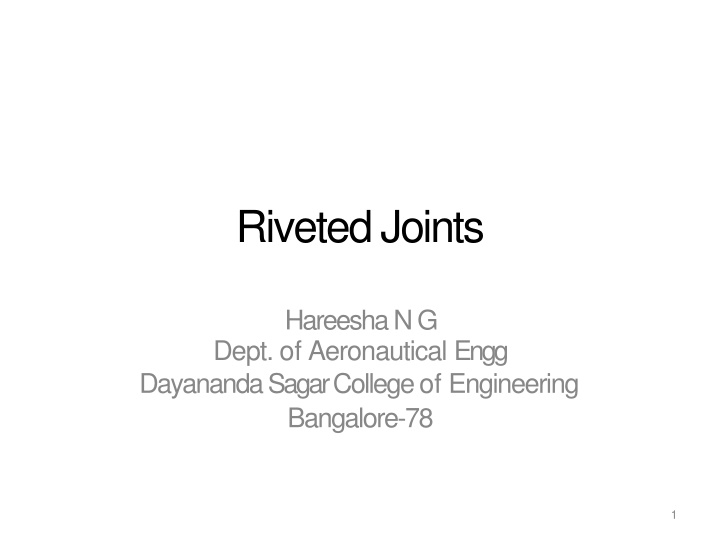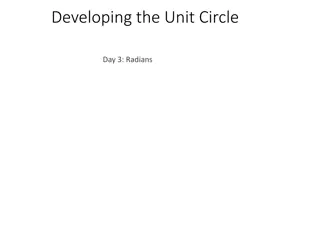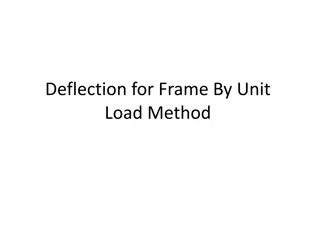
Riveted Joints in Engineering
Riveted joints play a crucial role in structural work, ship building, bridges, tanks, and boiler shells. This comprehensive guide covers the types of rivet heads, different riveted joint configurations like lap and butt joints, important terms used in riveted joints, and proportions of dimensions for effective construction. Dive into the world of riveted joints to enhance your knowledge in engineering applications.
Download Presentation

Please find below an Image/Link to download the presentation.
The content on the website is provided AS IS for your information and personal use only. It may not be sold, licensed, or shared on other websites without obtaining consent from the author. If you encounter any issues during the download, it is possible that the publisher has removed the file from their server.
You are allowed to download the files provided on this website for personal or commercial use, subject to the condition that they are used lawfully. All files are the property of their respective owners.
The content on the website is provided AS IS for your information and personal use only. It may not be sold, licensed, or shared on other websites without obtaining consent from the author.
E N D
Presentation Transcript
Riveted Joints Hareesha NG Dept. of Aeronautical Engg Dayananda Sagar College of Engineering Bangalore-78 1
Introduction Arivet isashort cylindricalbarwith aheadintegral to it. The cylindricalportion of the rivet is called shankorbody and lower portion of shank is known astail. The rivets are used to make permanent fastening betweenthe plates such as in structural work, ship building, bridges, tanks and boilershells. The riveted joints are widely used forjoining light metals. 2
Types of rivetedjoints 1. Lapjoint 2. Butt joint Lap joint: A lap joint is thatin which one plate overlaps the other andthe two platesarethen riveted together. Butt joint: A butt joint is that in which the main plates are kept in alignmentbutting (i.e.touching)eachotheranda coverplate (i.e. strap) is placed either on one side or on both sides of the main plates. The cover plate is then riveted together with the mainplates. Buttjoint 4 4 04/04/13 Hareesha N Gowda, DSCE,Blore-78 Lapjoint
Important Terms Used in Riveted Joints Thefollowing termsin connection with the riveted joints are important from the subjectpoint of view : 1.Pitch.Itisthedistancefromthecentreofonerivettothecentreof the next rivet measured parallel to the seam as shown in Fig. It is usually denoted byp. 2.Transverse pitch.Itis theperpendiculardistance betweenthecentre lines of the successive rows asshown in Fig. It is usually denoted by pt. 3.Diagonalpitch.Itisthedistancebetweenthecentresoftherivetsin adjacent rows of zig-zag riveted joint as shown in Fig. It is usually denoted bypd. 4.Margin or marginal pitch. It is the distance between the centre of rivetholetothenearest edgeof the plate asshownin Fig.It isusually denoted bym. 5 5 04/04/13 Hareesha N Gowda, DSCE,Blore-78
Proportions of dimensions of rivetedjoints Thickness ofplate t = Thickness of theplate Diameter ofrivets. thediameteroftherivet hole(d)maybedeterminedbyusing Distance of centre of the rivet from edgeof the plate = 1.5d Margin , m=d Longitudinal Pitchp=3d Transverse pitch pt = 0.8P for chainriveting = 0.6P for zig-zagriveting Thickness of buttstrap. Single cover plate t1 = 1.125t 04/04/13Doublecover pla Ht ae reest h2 aN= Gow0 da. ,7 DS Ct E,o Blor0 e-7. 88t 6 6
2 2
Bolt tightening with new materials BOLTED JOINTS by Erik Galdames Translation and adaptation of the presentation Condiciones reales de montaje at the Technical Meeting held on 20th July, 2012 organized by Galol, L Olleria (Spain) 2 3
Boltedjoints Bolt tightening in real conditions Basicconsiderations Tightening of bolts with new materials show a challenge when trying to obtain new results inthe design of bolted joints Not only considerations of individual components are to be taken into account in a separate way, it is necessary to know their interaction and behaviour in their different combinations Theoretical data or data from charts are not only the sources to be considered, it is of vital importance to know the behaviour of the different materials incontact These facts have contributed to seek for practical solutions in the different specifications of some industrial sectors, mainly automotive industry, tostudy and determine solutions forr different problems that may occur 24
Boltedjoints Bolt tightening in real conditions Basicconsiderations Types of fasteners Types of coatings Mating materials Thread length Environmental conditions 25
Boltedjoints Bolt tightening in real conditions Types offasteners Metric threaded bolts, nuts Self-tapping metric screws Self-tapping screws Studs 26
Boltedjoints Bolt tightening in real conditions Designconsiderations Geometry of parts Dimensions and tolerances Internally driven fasteners, externally driven Clearance hole Thread length Surface pressure. Use of washers, type of material to fasten 27
Boltedjoints Bolt tightening in real conditions Coatings offasteners The selection of the adequate coating for a certain application plays an important role. The following families of coatings for fasteners exist in the automotive industry nowadays, not exclusively: Zinc flake coatings with/without top-coats Electroplated zinc, zinc-nickel with/withouttop-coats Phosphating + oil 28
Boltedjoints Bolt tightening in real conditions Coatingsofthematingsurfaces Coatings applied to the mating surfaces to be fastened with bolts/nuts Zinc flake coatings with/without top-coats Electroplated zinc, zinc-nickel with/without top- coats KTL No coating (e.g.Al-alloys) 29
Boltedjoints Bolt tightening in real conditions Coatings Factors to be taken into account in their selection: Colour Property class of fasteners. Hydrogen embrittlement avoidance Tightening with hexalobular tool, internal hexagonal tool, etc. Presence of pilot (form of the tip of the bolt) Service temperature Use in combination with locking features or microencapsulated coatigns DIN 267-27 or DIN 267-28 Contact with magnesium alloys Ground connections 30
Boltedjoints Bolt tightening in real conditions Coatings Coating Typical applications Adequate for Less adequate for Chassis Motor compartment (areas exposed to highcorrosivity) Aluminium joints Bolts 10.9 Microencapsulated coating allowed (without lubricated top- coat) Ground connections External thread <M6 Internal thread <M10 Internal drive features T30 Zinc flake coatings Chassis Motor compartment (areas exposed to highcorrosivity) Aluminium joints External thread < M6 Internal thread <M10 Bolts 10.9, 1000 N/mm2 Though less hydrogen embrittlement risk than puree- plated Zn. Service temperature > 150 C ZnNi Chassis Motor compartment (areas exposed to highcorrosivity) Aluminium joints External thread < M6 with internal drive feature Internal thread<M10 Self-tapping screws Bolts 10.9, 1000 N/mm2 Though less hydrogen embrittlement risk than puree- plated Zn. Service temperature > 150 C ZnNi black Multicomponent, oil circuits or transportation Parts in motion without corrosion exposure Transport and limitedstorage in warehouses Parts not multi-component Service temperature > 180 C Phosphating + oil Mg alloys Parts in contactwith magnesium alloys Bolts 10.9 Zn+passivation+top-coat (silicate) Weldparts Weldparts Bolts 10.9 Zn+passivation 31
Boltedjoints Bolt tightening in real conditions Materials Typical materials found in bolted joints Chassis metal sheet Non-structural steel Sintered materials Cast steel Wrought Al alloys Cast Al alloys Mg alloys Ti alloys Zinc cast alloys 32
Boltedjoints Bolt tightening in real conditions Materials Material Abbreviation Material No. Standard Cold formedsteel DC01 S700MC 1.033 1.8974 EN 10130 EN 10149-2 Non-allied structural steel S355JR 1.0045 EN 10025-2 Steel for quenchingand tempering C45EC 34CrNiMo6 16MnCr5 1.1192 1.6582 1.7131 EN10263-4 EN10083-3 EN 10084 Sintered materials Sint D30 - DIN 30910-4 Austenitic stainless steel X5CrNi18-12 X5CrNiMo17-12-2 X6NiCrTiMoVB25-15-2 1.4303 1.4401 1.4980 EN 1008-3 EN 10269 Cast iron EN-GJL-150 EN-GJS-40015U EN-GJS-500-7U EN-GJS-600-3U EN-JL1020 EN-JS1072 EN-JS1082 EN-JS1092 EN 1561 EN 1563 33
Boltedjoints Bolt tightening in real conditions Materials Material Abbreviation Material No. Standard Cold formed Al alloys EN-AW-AlSi1MgMn-T6 EN AW-AlSi1MgMn-T4 EN AW-AlMg4, 5Mn0,7-H111 EN AW-6082 EN AW-6082 EN AW-5083 EN 754-2 Al alloy castings EN AC-AlSi6Cu4-SF EN AC-AlSi9Cu3(Fe) EN AC-AlSi7Mg0,3-T6 EN AC-45000 EN AC-46000 EN AC-42100 EN 1706 Mg alloys EN MC-MgAl9Zn1(A)-F-D EN MC-MgAl6Mn-D EN-MC21120 EN-MC21230 EN 1753 Ti alloys TiAl6V4 3.7165.1 DIN 17862 Zinc alloy castings ZP3 ZP5 ZP0400 ZP0410 EN 12844 34
Boltedjoints Bolt tightening in real conditions Matingmaterials Some softer materials present problems in the assembly due to the increase of friction. E.g. Al andMg alloys show higher friction compared to steel. The same bolt with the same coating may present different behaviour when the mating material is anAl-alloy Surface roughness plays an important role, as wellas geometry of the bearing surface of the fastener (concave, convex). This could influence the friction behaviour enormously. E.g. Worst case concave surface. Thread length also has a strong influence. When the mating surface between both elements to tighten is larger, unexpected effects may occur, since frictionin the thread is higher 35
Boltedjoints Bolt tightening in real conditions Threadlength MATERIAL Min. Rm Min. Brinell Hardness No. (BHN) 1000 MPa Longitud de roscado m n. (tornillos 10.9) Hardened steel, tempered Tempered steel, hardened Low-and unalloyed steel Al and Mg alloy castings 0,8 d 800 Mpa 1,0 d 400 Mpa 1,3 d 80 BHN 2,0 d (8.8) 2,5 d (10.9) 2,7 d ( 8.8) 1,3 d 1,0 d 60 BHN 350 MPa 510 MPa CuZn alloys Sintered parts 36
Boltedjoints Bolt tightening in real conditions Othermaterials Unions with self-tapping screws on plastics mayshow unexpected effects Creep of polymers produces drop of preload,thus loosening the union For unions with high preload, use of metal sleevesis recommended Microencapsulated coatings increase coefficient of friction during assembly. With the introduction of new developed products ( tot 0,12 to 0,16) this effect can be avoided It is not allowed in some automotive specs to use microencapsulated coatings over top-coats with integrated lubricants due to the risk of lack ofadhesion of the locking feature over thetop-coat 37
Boltedjoints Bolt tightening in real conditions Otherfactors Use of washers. They change pressure applied on the bolted union Geometry of washers (Aussentr ger or concave washer). The most complicated case in bolted unions due to the reduced contact surface Galvanic compatibility (galvanic series). Special attention to materials like Al, Mg or stainless steel. Cu. Not compatible with most of the coatings that provide cathodicprotection Al alloy. Compatible with zinc flake coatings,zinc-nickel AnodizedAl. Not recommended for fasteners with zinc flake coatings or electroplated zinc alloys Mg alloys. Not compatible with zinc flake coatings. Compatible with someelectroplated zinc coatings with specialtop-coats Specific surface. Avoid relatively small areas of the less noble metal with a larger surface of the most noble metal E.g. A zinc plated bolt fastened to an anodized aluminium sheet or a stainless steel panel. The surface of the bolt is smaller than the Al sheet (or stainless steel sheet). Finally, the bolt is corroded 38
Boltedjoints Bolt tightening in real conditions Otherfactors Galvanic series Platinum Gold Graphite Titanium Cathodic Silver Stainless steel (passive) Nickel (passive) Bronze Nickel (active) Lead Anodic Stainless steel (active) Iron Steel Aluminium Zinc Magnesium 39
Boltedjoints Bolt tightening in real conditions Temperature and relativehumidity Service temperature. There is a risk of self-looseningat high temperatures in some coatings with integrated lubricant due to loss of self-retention. For this reason, coating systems must comply with VDA 235-203 requirements before approval Relative humidity also has a strong influence.Before comparing results it is necessary that parts can be conditioned before testing. Relative humidity has influenced in the assembly conditions in some cases, so this has led to misinterpretation over the quality of the partsreceived by the customer Too high humidity may produce a higher lubricationand a too dry environment may increase coefficient of friction 40
Boltedjoints Bolt tightening in real conditions Otherfactors Type of tightening procedure Tightening below yield point. If torque controlled tightening is performed, friction has a strong influence and a short variation in torque may influence in a greater variation of preload. E.g. In torque controlled tightening, a torque variation of 15% T can produce a preload variation of F 35%. With angle controlled tightening F 13% Tightening beyond yield point. The maximum design of the bolt is used when bolt is assembled beyond the yield point. When bolt is tightened within the plastic range, friction under the head of the bolt plays a less important role with a torque/angle controlled tightening procedure High speed tightening. Tightening in two steps (e.g. 200 rpm, stop, final tightening at 20 rpm). Speed of rotation can be higher in some cases, thus friction effects may vary Use of spindle 41
Boltedjoints Bolt tightening in real conditions Summary In the design of bolted joints not only the mechanical characteristics of the bolt have to be considered individually. The other materials used in the unionplay a vital role Furthermore, not only the coating systems applied influence exclusively in the tightening process, other factors must be considered.A different coating system may influence tightening processdramatically It is of vital importance to know the conditions of the bolted union of the different materials, theirinteraction and how they behave in the different situations encountered Temperature and humidity conditions are also important, mainly when comparing differentunions 42
Boltedjoints Bolt tightening in real conditions Furtherreading VDI 2230-1 VDA 235-203 KAMAX Schraubenbrevier Pierre R. Roberge. Handbook of corrosion engineering K. Kayser. High-tensile bolted joints. Design Parameters, Assembly, Locking features K. H. K bler, W. J. Mages. Handbuch der hochfesten Schrauben 43






















